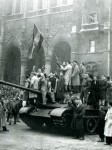
Hungary became part of the Soviet bloc in the early 1950s. Like other eastern European nations, it was ‘Sovietised’ against the will of its people. Post-war Hungary had been governed by a democratic coalition led by a conservative prime minister, Zoltan Tildy. The local communist party was vocal but small, receiving less than one-fifth of the vote in the 1945 elections. Hungary’s communists were backed by the Soviets, however, who maintained their occupation into the late 1940s. As in other places, Soviet agents interfered in Hungary’s domestic politics, manipulating local parties to facilitate communist rule. They achieved this in 1948, when Hungarian communist groups merged with local social democrats to form the Hungarian Working People’s Party. The new national leader was Matyas Rakosi, who modelled himself on Stalin and set out to mimic Soviet policies. In 1950 Rakosi created a political police force, the Allamvedelmi Hatosag (‘State Protection Authority’ or AVH). Over the next six years, more than a quarter-million Hungarians were arrested, imprisoned or murdered by the AVH for political crimes, both real and imagined. Rakosi’s regime also prioritised industrialisation and military spending – to the detriment of the people, who suffered shortages of food, fuel and consumer goods.
Nikita Khrushchev‘s 1956 denunciation of Joseph Stalin would have political implications for Hungary. On the orders of Moscow, Rakosi was replaced as leader and shipped out of Hungary. This fostered optimism among Hungarian students and workers, who believed that political reform and liberalisation might be imminent. At the head of this movement were students, who for years had been suppressed by the pro-Soviet government and AVH. Under Rakosi, Hungarian schools and universities had been forced to teach communist-approved syllabuses; learning Russian was also compulsory in many institutions. Teachers, academics and students who failed to abide by these regulations were sacked or expelled – or, in severe cases, dealt with by the AVH. In the autumn of 1956, student unions once banned under Rakosi were revived and students began organising discussion forums to debate the future of Hungary. In the capital Budapest, one group drafted a set of demands for political reform:
“1. We demand the immediate withdrawal of all Soviet troops…
2. We demand the election of new leaders in the Hungarian Workers’ Party … by secret ballot.
3. The government should be reconstituted … all criminal leaders of the Stalinist-Rakosi era should be relieved of their posts at once… …
12. We demand complete freedom of opinion and expression, freedom of the Press and a free Radio, as well as a new daily newspaper of large circulation…
13. We demand that statues of Stalin, the symbol of Stalinist tyranny and political oppression, should be removed as quickly as possible…”
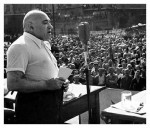
The student uprising grew into a popular uprising. On October 23rd more than 100,000 people gathered in Budapest, where the students’ demands were read and received with cheers. The crowd then marched on a ten-metre high bronze statue of Stalin in the centre of the city. They looped steel cables around its neck, pulled it to the ground with trucks and defaced the fallen icon. Such an act would have been unthinkable when Stalin was still alive. Elsewhere in Budapest, another group battled police outside a local radio station while AVH squadrons were besieged and attacked. Revolutionaries took over public buildings, destroyed Soviet symbols and opened the jails, freeing political prisoners who had been locked away for years. The violence continued until after midnight when the first Soviet tanks entered the capital to assist the AVH with restoring order.The presence of the Red Army did not daunt the citizens of Budapest, however. Some unpacked rifles to fire on the tanks while children darted out from alleys to hurl projectiles. There were a few attacks on Soviet soldiers but in most cases, they were welcomed and invited to join the rebels, with a few taking up the offer.
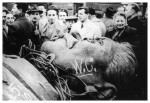
The first phase of this Hungarian Revolution, as it became known, was successful for the rebels. The pro-Soviet prime minister fled to Russia in fear of his life and the national leadership passed to Imre Nagy. On October 27th, Nagy acceded to popular demands by dissolving the AVH, abolishing one-party restrictions, promising free elections and an end to Soviet-style economic collectivisation. Political parties once banned under Rakosi began to reappear. At first, the Soviet government took no punitive action against Nagy and the new regime in Hungary. Orders were given to withdraw Soviet tanks and troops from Hungary. United States president Dwight Eisenhower hailed this Soviet restraint, calling it the “dawning of a new day” in eastern Europe. In reality, the Politburo in Moscow was equivocating and deliberating about what action to take. Hardliners wanted to send in tanks and crush the uprising, while moderates believed Hungary could be brought back into the Soviet fold with political pressure.
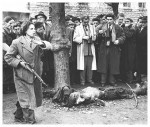
This Soviet inaction did not last long. On October 30th, mobs in Budapest attacked communist buildings and several AVH agents were killed. The following day, Imre Nagy bowed to public pressure and declared his government’s intention to withdraw Hungary from the Warsaw Pact. Both these developments convinced the Politburo to take firmer action against the dissidents in Hungary. To allow the uprising to proceed further might suggest weakness to the West and encourage similar uprisings elsewhere in the Soviet bloc. Warsaw Pact troops crossed the border and entered Hungarian territory at the end of October. Sensing an imminent invasion, Nagy’s cabinet declared Hungary’s neutrality, withdrew from the Warsaw Pact and appealed to the United Nations for assistance. The UN did not respond, however. To intervene in the Soviet bloc would invite confrontation with Soviet Russia, plus Western powers were already dealing with another international crisis in the Suez.
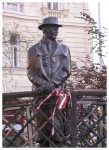
On November 3rd, Russian troops closed Hungary’s borders and surrounded Budapest. They entered the capital overnight and occupied the parliamentary building. Soviet troops marched along the streets of the capital, firing indiscriminately into buildings, while industrial areas – which Moscow believed housed most of the rebels – were destroyed by Russian artillery and airstrikes. Nagy remained in power until dawn on November 4th. He broadcasted the news that Budapest was under Soviet attack before taking refuge in the Yugoslav embassy. On the same day János Kádár, Nagy’s deputy prime minister, operating under instructions from Moscow, declared the formation of a counter-revolutionary government. Nagy was later arrested by the Soviets and given a secret trial, before being hanged. It took a week of fighting before Soviet troops were able to subdue resistance, with more than 2,500 Hungarians dying. Moscow installed Kádár as the new national leader. He would remain in control of Hungary’s government for more than 30 years.
“The western public, especially the younger generation, backed Hungary’s cause with all their heart and soul – perhaps due to the half-hearted political support that came from their own governments. Refugees were welcomed abroad. Many of today’s western politicians, presidents and prime ministers were among those who at the time demonstrated and protested in front of the Soviet embassies and embraced young Hungarian refugees… For them, the Hungarian revolution was a decisive experience of freedom, an uplifting experience that continues to benefit us. For the world, the name of Hungary has become synonymous with freedom and an elementary wish for democracy.”
Arpad Goncz
Hungarian politician
There was a mixed international response to the Hungarian Revolution and its brutal suppression by the Soviets. Both the UN and NATO were criticised for failing to come to the assistance of Nagy and his supporters. The UN convened a special inquiry into the events of October-November 1956, however, both the Hungarian and Soviet governments refused to participate. The inquiry resulted in a condemnation of the Kadar regime but no other action or significant findings. TIME magazine named the ‘Hungarian freedom fighter’ its ‘Man of the Year’ for 1956, describing him as having “shaken history’s greatest despotism to its foundations”. In the long term, the Hungarian Revolution served to harden the stalemate between East and West. It became clear to Western leaders that attempts to destabilise the Soviet bloc by promoting internal uprisings might only place the local population at risk. Other reform-minded leaders behind the Iron Curtain were also given a clear lesson in what might happen if they challenged Soviet control.

1. Post-war Hungary, like many of its eastern European neighbours, was occupied by the Soviets after World War II and subjected to ‘Sovietisation’.
2. In 1956, Khrushchev’s denunciation of Stalin undermined the leadership of Matyas Rakosi and ignited liberal reforms and protests in Hungary.
3. Started by a set of political demands drafted by students, the Hungarian uprising soon became a popular one, targeting the state police.
4. Moscow’s response to events in Hungary was equivocal at first, however, Warsaw Pact troops eventually invaded and quashed the uprising.
5. The Hungarian uprising ended with the arrest of Imre Nagy and the installation of Janos Kadar, a loyal Soviet communist, as the nation’s leader. Around 2,500 Hungarians were killed. The Soviet response invited criticism and condemnation around the world.

A report on US efforts to disseminate anti-communist propaganda in Hungary (March 1955)
The reformist demands of Hungarian students (October 1956)
British journalist Sefton Demler describes the Hungarian Uprising (October 1956)
Soviet leaders decide to suppress the uprising in Hungary (October 1956)
Hungary’s cabinet votes to withdraw from the Warsaw Pact (November 1956)
Hungarian prime minister Imre Nagy appeas for help from the UN (November 1956
Content on this page is © Alpha History 2018. This content may not be republished or distributed without permission. For more information please refer to our Terms of Use.
This page was written by Jennifer Llewellyn, Jim Southey and Steve Thompson. To reference this page, use the following citation:
J. Llewellyn et al, “The Hungarian uprising”, Alpha History, accessed [today’s date], https://alphahistory.com/coldwar/hungarian-uprising/.
